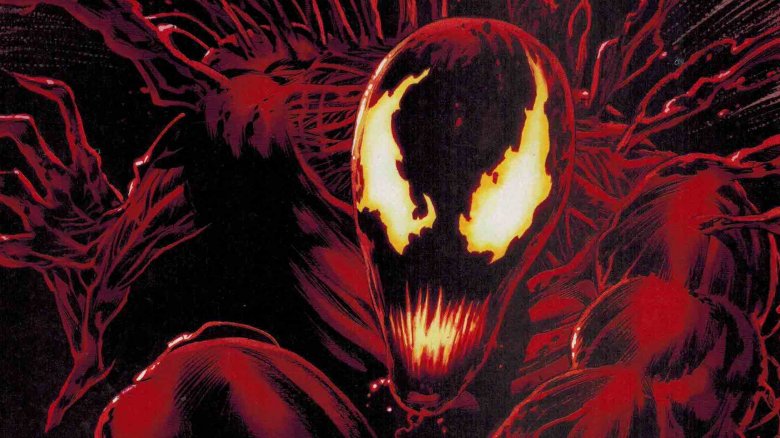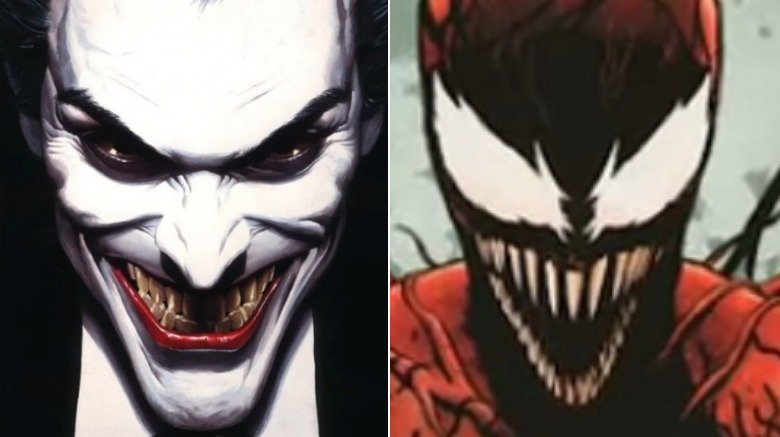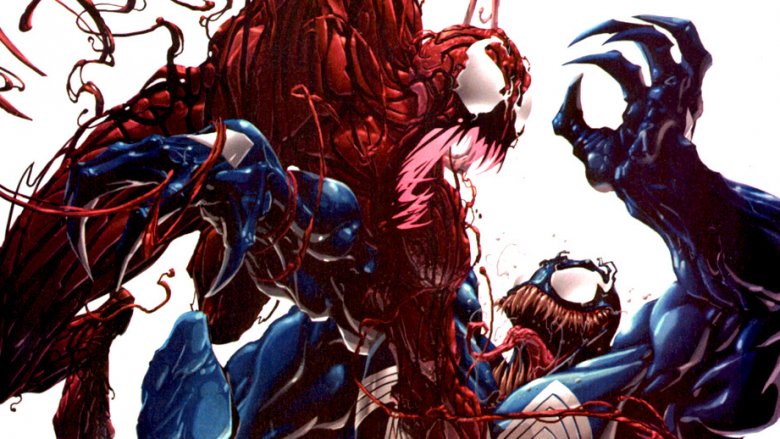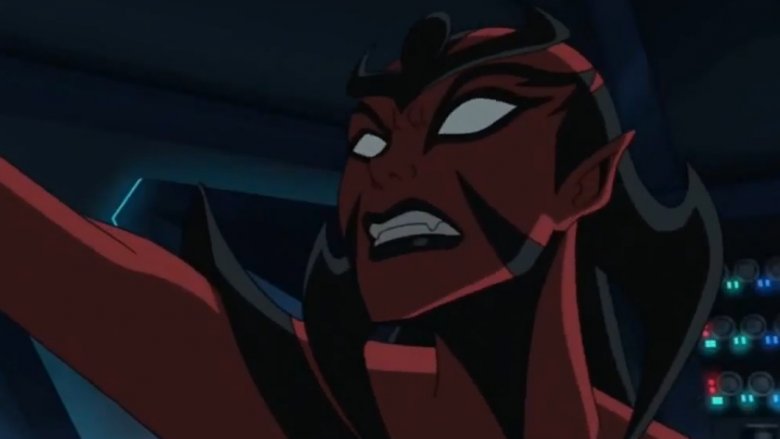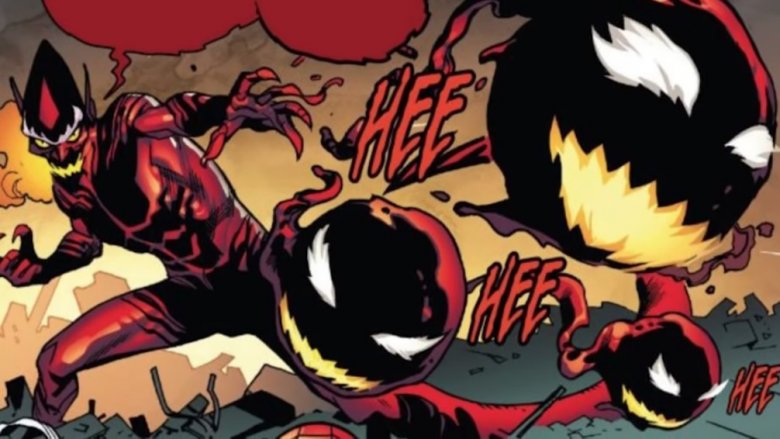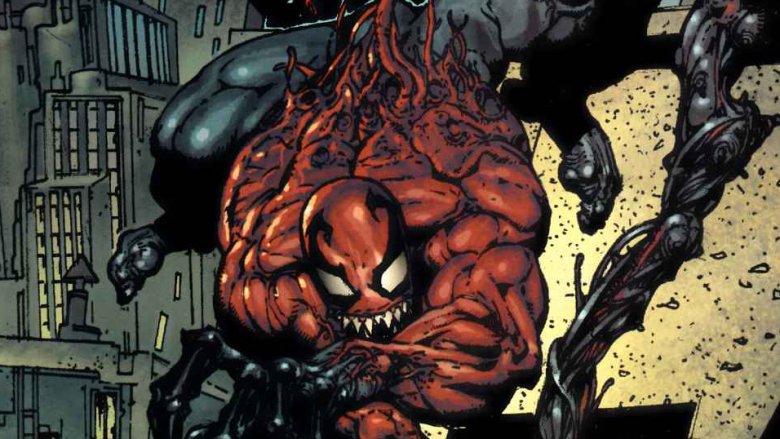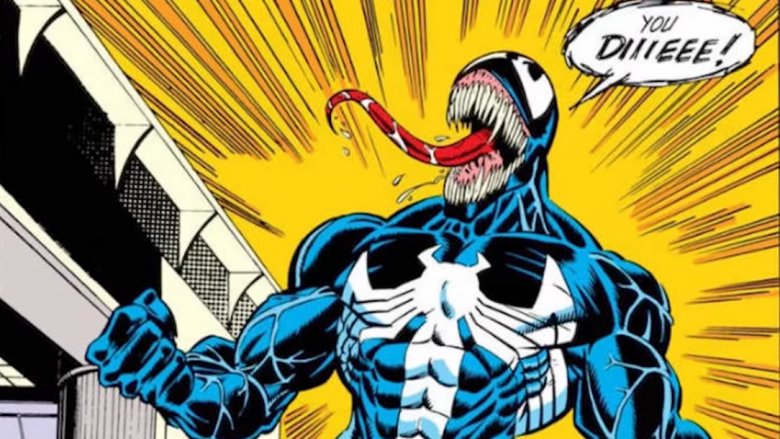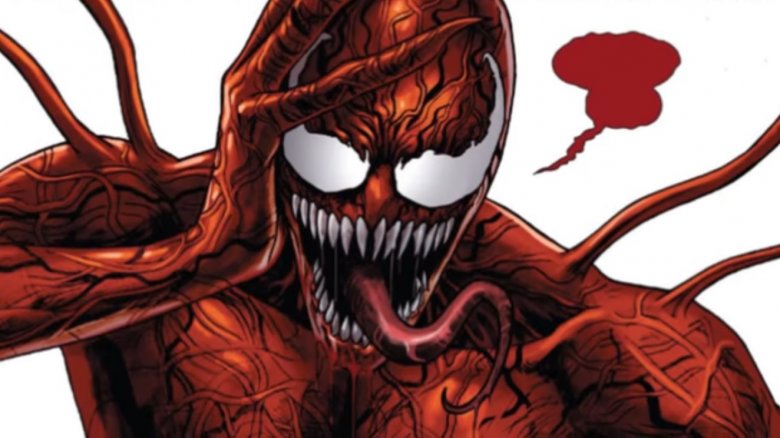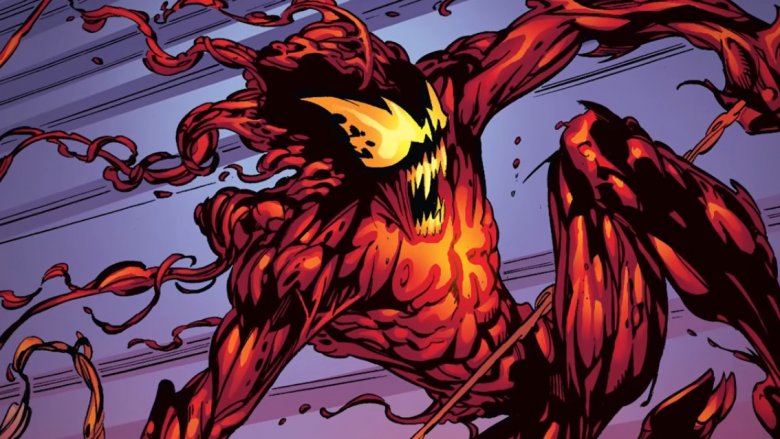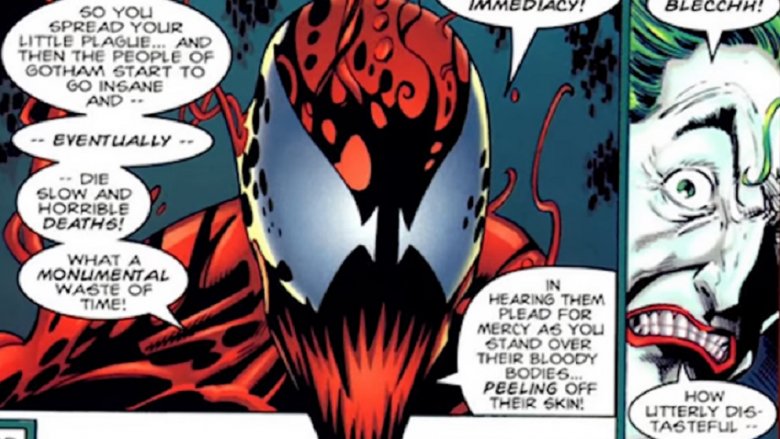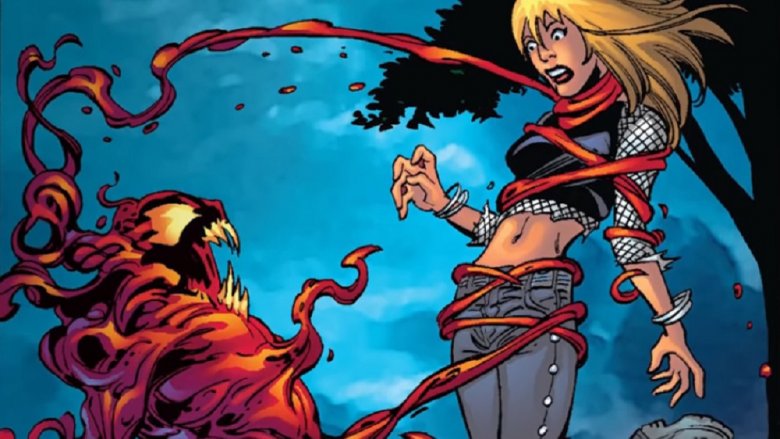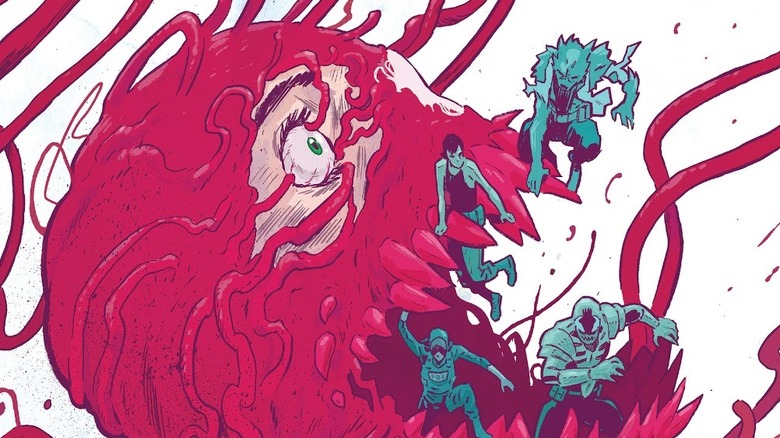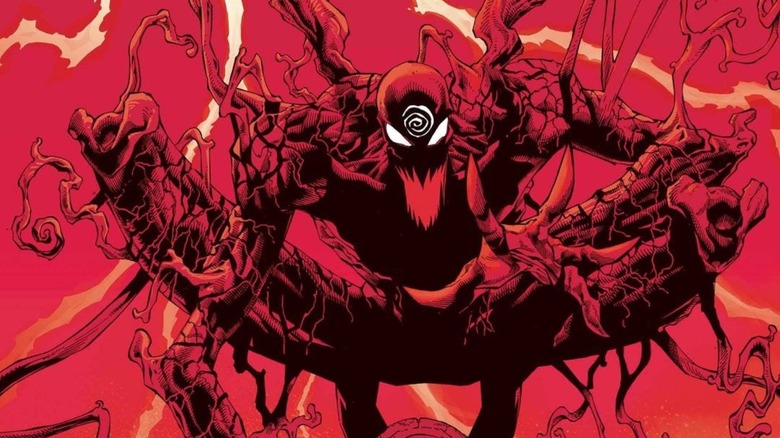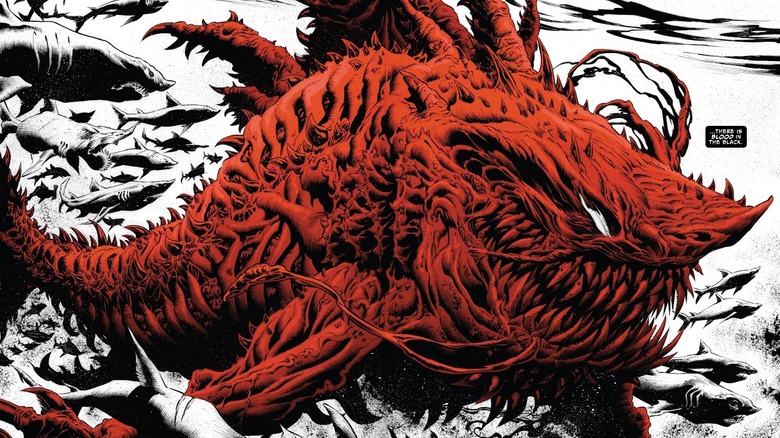The Untold Truth Of Carnage
The symbiotic alien being known as Venom has long been one of the scariest villains in Spider-Man's rogues' gallery. Originally bonded to Peter Parker in the guise of a snazzy black-and-white suit with strange powers of its own, it eventually revealed itself to be a malevolent if strangely principled sentient being. When rejected by Parker, it latched onto rival reporter Eddie Brock — a man with severe anger issues and an intense hatred of Parker and Spider-Man. Possessed of all of Spidey's powers but even stronger — and with knowledge of his secret identity — Venom has been a truly formidable foe (and, at times, uneasy ally) of the wall-crawler in Marvel comics for decades.
But for all of Brock's faults, he at least has a sense of morality, however skewed. In 1992, writer David Michelinie and artists Erik Larsen and Mark Bagley decided to explore the question of what would happen should one of Venom's race bond with a man with absolutely no morals to speak of — a bloodthirsty, sociopathic murderer. The terrifying answer: Carnage, a near-unstoppable force of evil so dangerous that on multiple occasions, Spidey and Venom have been forced to set aside their differences to put an end to his wrath. The character (spoiler) appeared in the mid-credits scene of 2018's feature film Venom, meaning we're about to see a lot more of him — so let's take a look at the chaotic mind and twisted motivations of Carnage, one of Marvel's deadliest villains.
He was modeled after the Joker
Carnage is the product of the bond between a member of the symbiotic alien race known as the Klyntar and Cletus Kasady, a deranged serial killer with a backstory as dark as any in all of comics. He began his career as a murderer by pushing his own grandmother down a flight of stairs as a child, and his father was sent to die in the electric chair for killing his mother; Casady was then sent to an orphanage, which he burned down. Suffice to say that he developed a lust for pure chaos and mayhem long before he ever came into contact with the symbiote — and when Michelinie, Larsen and Bagley were seeking inspiration for the character's appearance and traits, they didn't have to look far.
Michelinie conceived of Carnage as the closest thing to an irredeemably malevolent force as could exist in the Marvel Universe, and as such, Larsen modeled Kasady's likeness and many of his character traits on the Joker, who has long filled just such a role in the DC Universe. Michelinie's original intention was to kill off Eddie Brock, leaving the Venom symbiote to bond with other hosts including Kasady — but Marvel nixed that idea due to Venom's exploding popularity, which forced the writer to get a little more creative.
He's technically Venom's... son?
The stroke of fate which led to the creation of Carnage: Eddie Brock, separated from his symbiote and sent to prison for crimes committed as Venom, ended up as Kasady's cellmate. While waiting for the symbiote to spring him, Brock developed an antagonistic attitude toward the depraved Kasady, beating him mercilessly on more than one occasion. The Venom symbiote did eventually manage to free Brock — but in the process, it spawned (Klyntar reproduce asexually), leaving behind its offspring in Kasady's cell.
This technically makes Carnage Venom's son — but unlike the contentious bond Brock shares with Venom, in which the two sometimes seem to be dueling for control, Carnage sees its relationship with Kasady as more than symbiotic. Having entered the psychopath's body through a cut, the symbiote was able to bond with Kasady's very bloodstream — making the two extremely difficult to separate — and while Venom always refers to itself as "we," Carnage does not, viewing itself and Kasady as part of the same whole. Klyntar offspring are typically more powerful than their "parents," and this (plus the fact that Carnage was spawned not on its home planet but on Earth) makes it stronger than Venom and Spider-Man combined. Klyntar are typically disgusted by the spawning process and disdainful of their offspring, but Venom's hatred of Carnage is so intense that it even overrides his hatred of Spider-Man — and as far as Carnage is concerned, the feeling is mutual.
He's had a LOT of hosts
It might be tough to separate Carnage from Kasady, but it's certainly not impossible — and, when its favorite host isn't available for whatever reason, Carnage has no problem bonding with anyone unfortunate enough to cross its path. Its victims have even included Gwen Stacy (in the comics) and Mary Jane Watson (in the Ultimate Spider-Man animated series). John Jonah Jameson III (son of the Daily Bugle publisher) has also served as a host, and through a convoluted series of events, the symbiote even took control of Dr. Tanis Nieves, the psychiatrist of Carnage's "girlfriend" (the supervillainess Shriek) after being ripped in half and left to die in space by the Sentry.
But things get really dangerous when Carnage bonds with powered beings, which it has on multiple occasions. In one comics story arc, it bonded with Ben Reilly (operating as Spider-Man at the time) to create Spider-Carnage; in the Spider-Man animated series, it actually bonded with Peter Parker, who was only given the strength to break its hold when confronted with a still-living Uncle Ben from an alternate universe. But perhaps most terrifying of all: the symbiote once briefly bonded with the Silver Surfer to become Carnage Cosmic. In one reality (as seen in What If? #108), it was able to hold the bond long enough for its cosmic powers to become a world-ending threat — forcing the Surfer to kill himself (and the symbiote along with him) by flying into the Sun.
The most dangerous host of all
Whoever is acting as its host, Carnage is one of the more formidable enemies Spider-Man is ever likely to face — but in a 2018 arc written by famed Spidey scribe Dan Slott, Peter Parker came face-to-face with two of his deadliest enemies combined, as Norman Osborn — the Green Goblin — allowed the symbiote to bond with him. As evil and insane as Kasady, but far more cunning and clever, Osborn proved to be perhaps the most dangerous villain to ever host the Carnage symbiote as the "Red Goblin."
Already greatly enhanced by his Goblin serum, Osborn became exponentially more powerful while hosting Carnage, and the serum also greatly mitigated the vulnerabilities to fire and heat typical of symbiotes. Obsessed not just with killing Spider-Man but crushing his very soul, the Goblin threatened to slowly and painfully kill everyone Parker held dear unless he were to give up his crime-fighting ways. After a brawl that left the Daily Bugle offices in shambles and Flash Thompson (in possession of the Anti-Venom symbiote) dead, Parker revealed his desperation by allowing the Venom symbiote to bond with him for one last shot at victory over the Red Goblin. The battle would have resulted in Parker's death, had he not remembered Osborn's one weakness — his ego. Convincing him that Carnage, not the Goblin, would get all the credit for killing Spider-Man, Parker tricked Osborn into shedding the symbiote — which, of course, led to Osborn's sound defeat.
He has sons of his own
As previously mentioned, Klyntar are generally indifferent or antagonistic toward their offspring, and Carnage is no exception. During the brief time it was in control of Dr. Nieves, it used her to find Casady, abandoning her for his original host but leaving its spawn behind, growing on her arm. Horrified, Nieves took drastic action and cut the arm off — but symbiotes don't give up easily, and it eventually re-bonded with her to become the heroic Scorn, who has been a thorn in the side of her "father" on multiple occasions.
Another of Carnage's offspring wasn't abandoned, but outright rejected. Disgusted and enraged by its pregnancy, Carnage implanted its spawn into New York police officer "Paddy" Mulligan during a chance encounter. Resolving to kill it before it could reach maturity, Carnage attacked Mulligan and his family, but was foiled by Spider-Man and Black Cat. Mulligan (still unaware of his condition) subsequently tracked the Cat down for answers, but the pair once again came under attack by Carnage — and this time, the new symbiote made its presence known. Calling itself Toxin, it single-handedly took down both Carnage and Venom, and resolved to become a hero. The virtuous Mulligan had trouble containing the symbiote's homicidal urges, however, and when the officer was killed in battle, Toxin eventually bonded with Eddie Brock during one of his periods of separation from Venom.
Venom ate the original symbiote
Venom and Carnage have done battle countless times, with the latter's superior strength usually giving him the upper hand — but Venom is nothing if not opportunistic. At one point, Kasady was being held within a special prison designed to contain Carnage when Venom decided it was the perfect time to pay his "son" a visit. Kasady could only gibber helplessly as Venom ripped the symbiote from his body — and straight-up ate it.
Escaping from his imprisonment, Kasady attempted to resume his reign of terror by painting himself red and embarking on yet another killing spree as "Carnage," which did not go exactly as he'd planned. Easily defeated by Spider-Man, Kasady was given new hope when a failed invasion of Earth by the interdimensional beings of the Negative Zone reactivated dormant traces of the symbiote within his bloodstream. Finding his way through a portal to the Negative Zone (while pursued by Spider-Man), Kasady was mysteriously guided to a second symbiote, apparently identical to his first — and promptly and enthusiastically allowed it to bond with him, becoming Carnage once again.
He tried to be a hero once... with VERY mixed results
During the events of the Avengers/X-Men AXIS crossover event, the moral axes of a number of heroes and villains were magically switched. This had a profound and... well, hilarious effect on Carnage, which found itself saddled with an overwhelming desire to help people and do good despite having literally no idea how to go about this. It recruited (see: kidnapped) local reporter Alice Gleason to tutor it in the ways of being a hero after barely restraining itself from killing a couple of random thugs — but even under her strict guidance, Carnage tended to get its wires crossed.
For example, when Carnage and Alice came across a bank being robbed, the symbiote heroically thwarted the robbery — before attempting to burn down the bank (to prevent future robberies, of course). While apparently developing romantic feelings for Alice, Carnage was constantly distracted by fantasies of murdering her. During the event's climactic battle in New York, Carnage apparently sacrificed itself for the good of the city (but not before making Spider-Man promise to build a huge, rhinestone statue of it to commemorate its sacrifice). But of course, such deaths are almost always temporary in the Marvel Universe — and it wouldn't be long before Kasady appeared once again, back to his old sociopathic ways.
Ultimate Carnage is somehow even scarier
Marvel's Ultimate line of comics, which began publication in 2000, was a (mostly successful) attempt to update some of its most popular characters and storylines for a new generation of readers. It took place in a different continuity than the mainstream Marvel Universe, and while it is now defunct, some of its more popular original characters (such as Miles Morales) managed to survive the destruction of their home universe, and have since been ported over to the main continuity.
In this universe, the nature of the symbiotes was a bit... different. Rather than being an alien race, they're the result of a genetic experiment carried out by Richard Parker (Peter's father) and Eddie Brock, Sr. The first of these symbiotes was Venom, and its relationship to Peter Parker and Eddie Jr. played out much the same way it did in the main continuity. Carnage, however, was something different. It was created in a lab by Dr. Curt Connors, who had the bright idea to combine some of Peter's DNA with a sample of the Venom suit, along with his own Lizard-mutated DNA. The result: a fearsome beast which could only survive by feeding on humans, and was obsessed with consuming Peter Parker (and, later, Miles Morales) in order to complete its DNA sequence. It even ate Gwen Stacy, then created an exact genetic replica of her (down to her memories) in order to serve as its host. This version of Carnage was itself eventually consumed — by Venom, of course.
Crossovers with... DC Comics?
Carnage has been a player in a good number of Marvel crossover events, but not even the Marvel Multiverse can contain him. On a couple of the rare occasions in which Marvel has teamed up with rival publisher DC for crossovers, Carnage has been involved, as well — notably teaming up with his inspiration the Joker for the 1995 one-shot Spider-Man and Batman: Disordered Minds. The teamup, however, was short-lived; although they seem like the perfect complement to each other, Carnage butted heads with the Clown Prince of Crime early and often due to the Joker's tendency toward theatrics and his own preference for wanton slaughter. In short, Carnage found the Joker's methods to be tedious and unsatisfying, while the Joker found Carnage to be a hack.
But perhaps the strangest appearance of Carnage in a non-Marvel property came with the creation of the Amalgam line of comics, an imprint in which Marvel and DC heroes and villains were combined to create new mashup characters. Carnage was mashed up with Superman nemesis Bizarro to create — you guessed it — Bizarnage, the result of an attempt to replicate alien DNA which went horribly wrong. The creature wreaked indiscriminate havoc until it was eventually tricked and defeated by Spider-Boy (a mashup of Spider-Man and Superboy).
Doubling down on the darkness
Although Carnage was dispatched during the 2018 Venomized story arc, the charcter's surprise cameo in the Tom Hardy-led Venom feature film promised to raise his profile, and Marvel has teased his return to the comics page with the Web of Venom: Carnage Born one-shot. Its story deals with a cult attempting to resurrect the villain, and if that's not dark enough, it's retconning Kasady's background to make him not just a murderer, but a cannibal.
To be clear, Carnage has always been implied (if not outright portrayed) to have a bit of a taste for human flesh — but Kasady himself had always been portrayed simply as a murderous psychopath up until this point. Not anymore: Kasady's retconned backstory will now include the fact that he had a proclivity for munching on his victims even before his fateful meeting with the offspring of Venom, making him about as terrifying and irredeemable character as has ever graced the pages of Marvel Comics. This is almost certainly by design: with the runaway success of Venom, a sequel is all but certain, and producers have implied that Carnage was strategically held back from a major role in the film so the character could be adequately built up for part two. With Marvel comics giving us a revamped and even darker version of the character, Venom 2 could be primed to give us a cinematic villain for the ages — and it certainly doesn't hurt that the great Woody Harrelson is filling the role.
Carnage gets his own series
Carnage has enjoyed plenty of miniseries, one-shots, and even line-wide events based on his bloody exploits, but the release of 2016's "Carnage" #1 gave the crazed symbiote his first regular, monthly series. It also marked the return of Gerry Conway to Marvel. Conway began his comic book writing career in the late '60s, but his gig on "Carnage" was his first work on a regular Marvel series since the '90s.
The series finds the eponymous villain lured to Grey Ridge Mine with Manuela Calderon — the sole survivor of Cletus Kasady's very first mass killing — used as bait. But when the owner of the mine turns out to have his own agenda, Carnage and some of the agents assigned with capturing him fall into the mine. A task force comprised of Calderon, Eddie Brock (bonded to the symbiote Toxin at this point), John Jameson (aka Man-Wolf), and FBI Special Agent Claire Dixon follow Carnage into the depths, where a strange cult called the Darkholders wait with their own plans for Carnage.
Before the series' conclusion with 2017's "Carnage" #16, a lot happens, both to Carnage and the heroes pursuing him. Most of it revolves around an unexpected mystical and prophetic connection between Carnage and the Lovecraftian god Chthon. Before the end, Carnage gets a power boost, and one of the heroes chasing him becomes part of the violent symbiote family.
Absolute Carnage
Carnage dies a lot. Characteristically, as a Marvel Comics character, he comes back a lot. For example, he dies toward the end of the 2018 event "Venomized," but returns with the help of the Cult of Knull later that year in "Web of Venom: Carnage Born" #1, planting the seeds for the 2019-20 event "Absolute Carnage."
In the "Venom" volume premiering in 2018, we learn that the Klyntari symbiotes are not just another alien species, but parasites created by the eldritch god Knull to do his bidding. After the Cult of Knull resurrects Carnage, they reveal that every human on Earth to ever bond with a symbiote has what they call a "codex" embedded in their DNA. If Carnage collects all of these codexes — some of which are in corpses and others in the bodies of superheroes like Spider-Man, Captain America, The Thing, and more — he will become the vessel for Knull on Earth and be able to conquer the world.
After a lot of bloodshed — including the deaths of a superhero or two — Venom kills Cletus in 2020's "Absolute Carnage" #5 but in doing so, ensures the eventual assault on Earth by Knull.
Carnage is a no-show for King in Black
While Venom destroyed Cletus Kasady's body, his consciousness endured in the symbiotes' hivemind. In 2020's "King in Black," the symbiote god Knull brutally murdered the powerful superhero Sentry in the miniseries' first issue. Bonded to a shark to create one of the scariest looking things you'll ever see underwater, Carnage wants to get in on the action, but in 2021's "Carnage: Black, White and Blood" #2 we find out why Carnage is a no-show for the event.
By the time Carnage leaves the ocean waters for the deck of a whaling vessel, Venom has already defeated Knull and replaced him as the new god of the symbiotes. Sensing his old enemy, Venom decides to let Kasady know he is no longer welcome among his people. Klyntari rain from the sky onto the deck of the ship and chase Carnage back into the ocean. In the depths, Venom's symbiotes bond with nearby sharks who converge on Carnage and devour him.
Extreme Carnage
In "Extreme Carnage" — an event arriving in a series of eight one-shots concluding with the upcoming "Extreme Carnage Omega" #1 — the titular serial killer finds a way to reach out across the airwaves to assert control over other symbiotes, including the so-called Life Foundation Symbiotes.
In spite of being made into a shark meal in "Carnage: Black, White and Blood," in 2021's "Extreme Carnage Alpha" #1, we see a piece of the symbiote survive at the bottom of the ocean which bonds with a fish, another shark, and so on until he bonds with the extremist xenophobic Senator Peter Krane. In the wake of "King in Black," Krane is calling for the end of "harboring" any and all extraterrestrial aliens on U.S. soil, and Carnage uses his voice for something else entirely.
In the one-shots that follow, somehow Carnage is able to use Senator Peter Kane's voice across the airwaves to reach out and seize the wills of various symbiotes. While the event is still unfolding, so far the only established superheroes facing Carnage's enthralled symbiotes are Flash Thompson — now Agent Anti-Venom — and Andi Benton, the former host of the symbiote Scream. In "Extreme Carnage: Scream" #1 Benton is forced to cripple her symbiote with hellfire to stop it from following Carnage's orders, and in "Extreme Carnage: Lasher" #1, she rebonds with an altered version of the symbiote now calling itself Silence.
